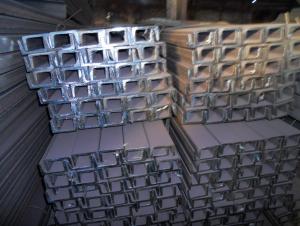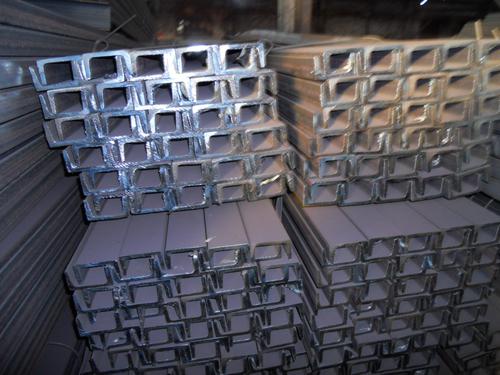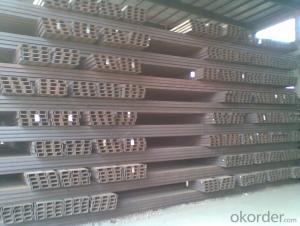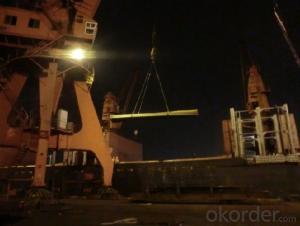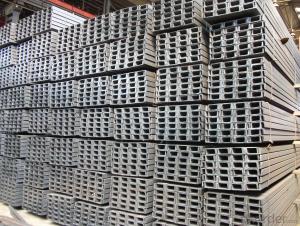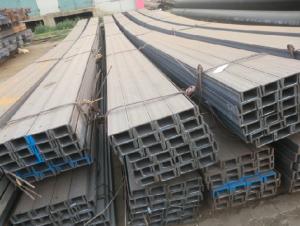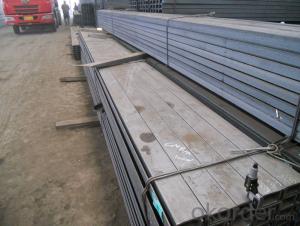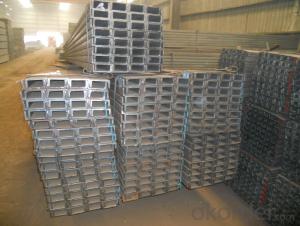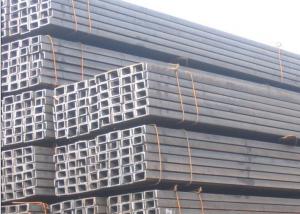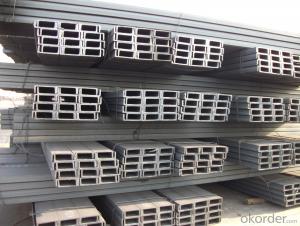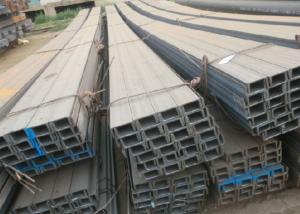14# Steel Channel
- Loading Port:
- China Main Port
- Payment Terms:
- TT OR LC
- Min Order Qty:
- -
- Supply Capability:
- -
OKorder Service Pledge
OKorder Financial Service
You Might Also Like
Steel Channel
Size: 140*58*6*9.5mm
Length: 6m, 12m
Material: GB Q235
1. The chemical composition of HR Channel Steel according to Q235B is shown in Table-1.
Alloy No | Grade | Element(%) | ||||
C | Mn | S | P | Si | ||
Q235 | B | 0.12-0.20 | 0.3-0.7 | ≦0.045 | ≦0.045 | ≦0.3 |
Table-1
Note: we are able to present our customers relevant SGS test report for chemical composition of HR Channel Steel.
2. The mechanical property of HR Channel Steel according to Q235B is shown in Table-2
Alloy No | Grade | Yielding Strength Point(Mpa) | |||
Thickness(mm) | |||||
≦16 | >16-40 | >40-60 | >60-100 | ||
≧ | |||||
Q235 | B | 235 | 225 | 215 | 205 |
Table-2
- Q: What are the different methods of painting steel channels?
- There are several methods of painting steel channels, each with its own advantages and considerations. 1. Brush painting: This is the most basic and traditional method of painting steel channels. It involves using a paintbrush to apply paint directly onto the surface of the channel. Brush painting is suitable for smaller projects or areas that require precise and detailed work. However, it can be time-consuming and may result in brush marks or uneven coverage. 2. Spray painting: Spray painting is a popular method for painting steel channels, especially for larger projects or areas that require a smooth and even finish. It involves using a spray gun or aerosol can to apply a fine mist of paint onto the surface. Spray painting allows for quick and efficient coverage, and it can reach difficult-to-access areas. However, it requires proper ventilation and protective equipment to ensure safety. 3. Powder coating: Powder coating is a highly durable and long-lasting method of painting steel channels. It involves applying a dry powder paint onto the surface, which is then cured with heat to form a smooth and protective finish. Powder coating offers excellent resistance against corrosion, chemicals, and UV rays. It is commonly used in industrial applications and provides a wide range of color options. However, powder coating requires specialized equipment and expertise, making it more suitable for professional applications. 4. Electrostatic painting: Electrostatic painting is a technique that uses electrostatic charge to attract paint particles onto the steel channel's surface. It involves using a spray gun that produces a charged paint mist, which is then attracted to the grounded channel. This method ensures even coverage and minimizes overspray. Electrostatic painting is commonly used in situations where a high-quality finish and uniform coating thickness are required. 5. Dip painting: Dip painting involves immersing the steel channel into a tank or container filled with paint. This method is suitable for objects with complex shapes or hard-to-reach areas. The channel is dipped into the paint, allowing it to coat the surface evenly. Dip painting can achieve a uniform finish, but it requires careful control of the immersion process to prevent excess paint buildup or drips. Each method has its own advantages and considerations, and the choice of painting method depends on factors such as the project size, desired finish, durability requirements, and available resources. It is important to consider the specific needs and constraints of the project before selecting the most suitable method for painting steel channels.
- Q: Can steel channels be used in seismic zones?
- Seismic zones can accommodate steel channels as they possess the necessary strength and flexibility to withstand the forces generated during an earthquake. Steel, being a robust and ductile material, can flex and deform without fracturing or collapsing. This is particularly important in seismic zones, where materials must possess the ability to endure such strains. Steel channels are widely utilized in seismic design and construction due to their exceptional load-bearing capacity and resistance to bending and twisting forces. They serve as structural components in buildings and bridges, supporting heavy loads and providing stability. To further enhance their seismic performance, steel channels can be reinforced through measures like bracing or cross-section enhancements. These reinforcements aid in the even distribution of seismic forces, reducing the likelihood of failure or damage. However, it is crucial to adhere to building codes and regulations specific to the region when designing and installing steel channels in seismic zones. These codes typically offer guidelines for seismic design and stipulate the minimum requirements for structural elements, ensuring the safety and stability of the structure. In conclusion, steel channels are an effective choice for seismic zones due to their strength, ductility, and ability to withstand seismic forces. Nonetheless, it is vital to prioritize proper design, installation, and compliance with building codes to guarantee their performance and safety in such areas.
- Q: What are the acceptance criteria for channel steel?
- The raw material for producing channel steel is carbon or low alloy steel billets with a carbon content of not more than 0.25%. The finished channel steel is delivered by hot forming, normalizing or hot rolling.
- Q: What are the different types of clamps used for steel channels?
- There are several different types of clamps used for steel channels, including beam clamps, channel clamps, strut clamps, pipe clamps, and C-clamps. Each type of clamp is designed to securely hold steel channels in place and provide support for various applications.
- Q: What are the load-bearing properties of steel channels?
- Steel channels have excellent load-bearing properties due to their shape and material composition. The "C" or "U" shape of steel channels provides structural support and stability. The flanges, or horizontal sections, of the channel resist bending moments, while the web, or vertical section, contributes to the channel's overall strength. The load-bearing capacity of steel channels depends on various factors, including their dimensions, thickness, and the grade of steel used. Higher-grade steels typically have greater tensile and yield strengths, enabling them to withstand heavier loads. Steel channels also offer high resistance to compression, making them suitable for applications that require support against vertical forces. Additionally, steel channels can be reinforced or braced to enhance their load-bearing capabilities. This can involve adding additional supports, such as beams or columns, or employing engineering techniques like stiffening plates or welding. Steel channels find numerous applications in construction, infrastructure, and industrial projects, where they are used to support beams, columns, and other structural elements. They are commonly used in the construction of buildings, bridges, factories, and even in vehicle frames. Their load-bearing properties make them a reliable choice for handling heavy loads and ensuring structural integrity.
- Q: How do steel channels perform in high-load applications?
- Steel channels perform exceptionally well in high-load applications. Due to their sturdy construction and high strength-to-weight ratio, they can effectively bear heavy loads without deformation or failure. Additionally, the structural integrity of steel channels ensures long-term durability, making them an ideal choice for high-load applications where reliability is crucial.
- Q: Can steel channels be used in the construction of soundproof walls?
- Soundproof walls can be constructed using steel channels. Steel channels, also known as steel studs or metal studs, are widely used in the construction industry due to their strength, durability, and versatility. When building soundproof walls, it is crucial to minimize any gaps or weak spots that could allow sound to pass through. By using steel channels, a solid framework can be created for the wall, ensuring a tight and secure structure that effectively blocks sound transmission. In the construction of soundproof walls, steel channels are typically employed as the framing material. They are installed vertically from floor to ceiling and horizontally between the top and bottom plates to establish a robust framework. This framework is then filled with soundproofing materials like insulation, mass-loaded vinyl, or acoustic panels to enhance the wall's soundproofing capabilities. The rigidity and strength of steel channels make them suitable for supporting heavy soundproofing materials, ensuring the wall remains intact even under significant sound pressure. Furthermore, steel channels are resistant to warping, rotting, and termite infestations, making them a durable option for long-lasting soundproof walls. However, it is important to acknowledge that the overall effectiveness of a soundproof wall depends on various factors, such as the selection of soundproofing materials, construction techniques, and proper installation. Steel channels alone may not provide complete soundproofing, as sound can still travel through other elements like doors, windows, or the ceiling. Therefore, it is essential to adopt a comprehensive approach to soundproofing, addressing all potential weak points in the construction process to achieve optimal results.
- Q: How are steel channels protected against corrosion?
- Steel channels can be protected against corrosion through various methods. One common method is the application of a protective coating, such as paint or epoxy, on the surface of the channels. This coating acts as a barrier between the steel and the corrosive elements in the environment, preventing direct contact and reducing the risk of corrosion. Another method is the use of galvanization, which involves coating the steel channels with a layer of zinc. This zinc coating acts as a sacrificial layer, meaning that it corrodes instead of the steel when exposed to corrosive elements. This helps to extend the lifespan of the steel channels and provide long-term protection against corrosion. In addition to protective coatings, steel channels can also be protected through the use of cathodic protection. This involves the application of an electric current to the steel channels, which helps to neutralize the corrosive reactions that lead to corrosion. Cathodic protection is often used in conjunction with other protective measures to provide effective corrosion protection. Regular maintenance and inspection are also crucial in protecting steel channels against corrosion. Any signs of damage or deterioration should be identified and addressed promptly to prevent further corrosion. Cleaning the channels regularly and removing any contaminants or debris can also help to minimize the risk of corrosion. Overall, a combination of protective coatings, galvanization, cathodic protection, and regular maintenance can effectively protect steel channels against corrosion and extend their lifespan.
- Q: Can steel channels be used in the construction of bridges?
- Steel channels are indeed applicable for bridge construction. These structural components possess remarkable strength and stiffness, rendering them an excellent choice for such projects. Notably, they are frequently employed in constructing the essential framework and supports of bridges, effectively ensuring stability and load-bearing capabilities. Furthermore, steel channels offer great versatility as they can be fabricated into various shapes and sizes, enabling flexibility in bridge design. It is worth noting that steel is highly durable and long-lasting, capable of withstanding heavy loads, adverse weather conditions, and other environmental factors. Consequently, it is a highly suitable material for bridge construction. In summary, due to their strength, versatility, and durability, steel channels are widely utilized in bridge construction.
- Q: Channel 18, number 18. What does it mean?
- The theoretical weight of 19.752 kg per metre, channel 18#a specifications 180X, 68x 7 mm, theoretical weight of 20.174 kg per meter, channel 18#b specifications 180 X70 x9mm, theoretical weight of 23 kg per meter, specifications are x height, X leg width, waist thickness.
Send your message to us
14# Steel Channel
- Loading Port:
- China Main Port
- Payment Terms:
- TT OR LC
- Min Order Qty:
- -
- Supply Capability:
- -
OKorder Service Pledge
OKorder Financial Service
Similar products
Hot products
Hot Searches
Related keywords
